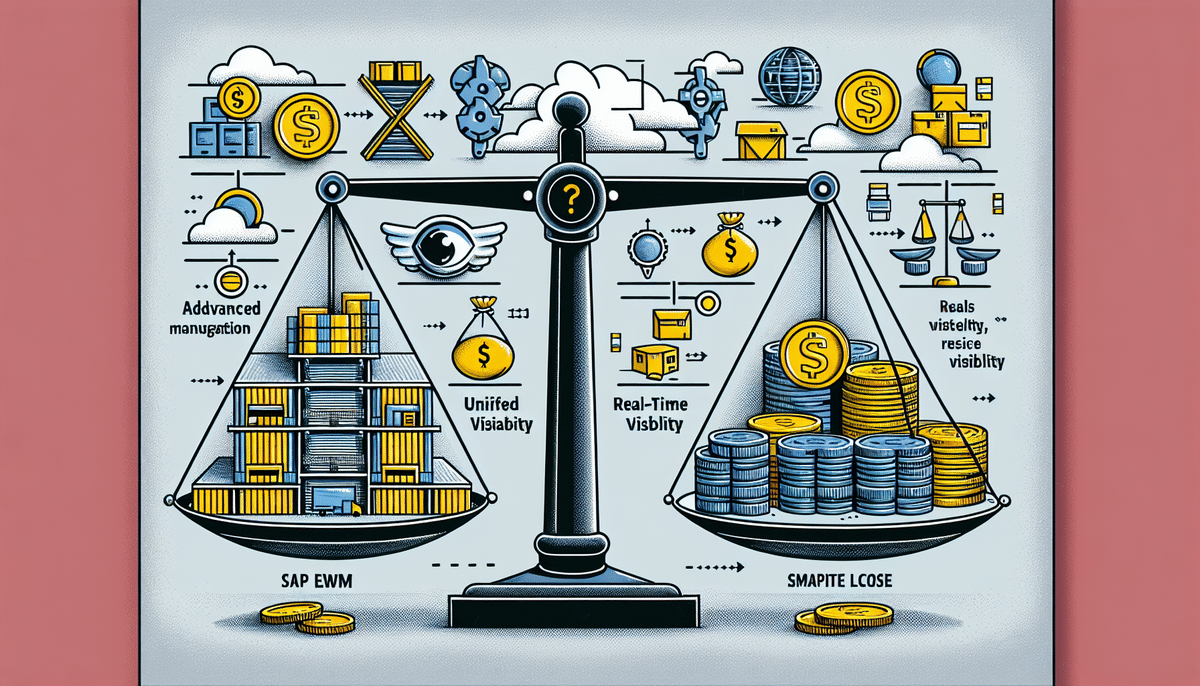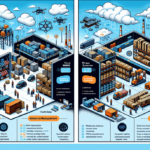Comparing SAP Extended Warehouse Management (EWM) and NetSuite WMS
Effective inventory management and streamlined warehouse operations are vital for business success in today’s competitive landscape. Warehouse Management Systems (WMS) like SAP Extended Warehouse Management (EWM) and NetSuite WMS offer comprehensive solutions to optimize these processes. This guide delves into the features, benefits, and key differences between SAP EWM and NetSuite WMS to help businesses determine which system aligns best with their needs.
Overview of SAP Extended Warehouse Management (EWM)
SAP Extended Warehouse Management (EWM) is an advanced WMS designed to cater to businesses of various sizes, offering robust tools for managing complex warehouse operations. Key features include:
- Advanced inventory management
- Order fulfillment optimization
- Supply chain planning capabilities
- Customizable reporting
- Integration with SAP ERP and SAP S/4HANA
SAP EWM supports automation technologies such as Automated Storage and Retrieval Systems (AS/RS) and Robotic Process Automation (RPA), enhancing productivity and reducing labor costs. Its deep integration within the SAP ecosystem ensures seamless data flow and process efficiency.
Overview of NetSuite WMS
NetSuite WMS is a cloud-based warehouse management solution that provides real-time visibility and control over warehouse operations. Its primary features include:
- Real-time inventory tracking
- Order management and fulfillment
- Shipping management
- Customizable reporting tools
- Integration with NetSuite ERP and CRM
NetSuite WMS is known for its user-friendly interface and ease of implementation, making it an attractive option for mid-sized businesses looking for scalable warehouse management solutions. Its cloud-based nature ensures accessibility and reduces the need for significant upfront investments.
Feature Comparison
Inventory Management
SAP EWM offers comprehensive inventory management features, including batch and serial number tracking, handling unit management, and sophisticated putaway strategies. According to a Gartner report, businesses using SAP EWM experience a 20% improvement in inventory accuracy.
NetSuite WMS provides real-time inventory visibility, cycle counting, and demand planning tools. Its integration with NetSuite’s ERP system allows for accurate demand forecasting and inventory replenishment.
Warehouse Operations
SAP EWM excels in managing complex warehouse operations, including multi-site and multi-channel logistics. It supports advanced picking strategies, wave management, and cross-docking, which are essential for large-scale operations.
NetSuite WMS is tailored for simpler warehouse operations, offering streamlined processes for order picking, packing, and shipping. Its real-time tracking capabilities enhance operational transparency and efficiency.
Order Fulfillment
Both systems provide robust order fulfillment features. SAP EWM supports advanced wave processing and sequencing, enabling efficient handling of large order volumes. It also integrates seamlessly with SAP’s transportation management solutions.
NetSuite WMS offers integrated shipping management and automated order processing, reducing errors and speeding up fulfillment times. Businesses report a 15% increase in order accuracy after implementing NetSuite WMS, as noted in a Forrester study.
Cost of Ownership
When evaluating the total cost of ownership, SAP EWM generally incurs higher implementation and maintenance costs due to its extensive features and customization capabilities. According to Capterra, businesses investing in SAP EWM benefit from long-term scalability and robust support, justified by a higher initial investment.
In contrast, NetSuite WMS operates on a subscription-based model with lower upfront costs, making it a cost-effective choice for mid-sized businesses. The reduced need for specialized IT resources further lowers the overall cost.
Integration and Scalability
SAP EWM seamlessly integrates with other SAP modules such as SAP ERP and SAP S/4HANA, providing a unified platform for enterprise resource planning and supply chain management. This integration supports scalability for large enterprises with complex operational needs.
NetSuite WMS integrates effortlessly with NetSuite’s suite of applications, including ERP and CRM systems. Its cloud-based architecture allows businesses to scale operations without significant infrastructure changes, making it suitable for growing mid-sized companies.
User Interface and Data Analytics
SAP EWM features a traditional, menu-based interface that may require training for new users but offers consistency across different modules. Its data analytics capabilities include advanced planning and predictive analytics, enabling informed decision-making.
NetSuite WMS offers a highly customizable dashboard, allowing users to tailor their view according to specific needs. Its reporting tools are user-friendly and provide actionable insights, assisting businesses in optimizing warehouse operations.
Customer Reviews and Case Studies
Both SAP EWM and NetSuite WMS have received positive feedback from users across various industries. For instance, a Software Advice review highlights SAP EWM’s robust functionality and integration capabilities, while a TrustRadius review praises NetSuite WMS for its ease of use and quick implementation.
Case studies from manufacturing and retail sectors demonstrate significant improvements in inventory accuracy, order fulfillment speed, and overall operational efficiency after implementing these WMS solutions.
Conclusion: Choosing the Right WMS for Your Business
Choosing between SAP Extended Warehouse Management (EWM) and NetSuite WMS depends on your business’s specific needs and scale. SAP EWM is ideal for large enterprises requiring comprehensive, customizable solutions with deep integration into SAP ecosystems. On the other hand, NetSuite WMS is better suited for mid-sized businesses seeking a cost-effective, scalable, and user-friendly warehouse management system.
Evaluate your business requirements, budget constraints, and long-term growth plans to make an informed decision. Both systems offer robust features and benefits that can significantly enhance your warehouse operations and inventory management.






















